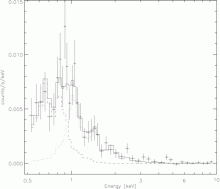
Abstract
We report the XMM-Newton/EPIC detection in 2008 March of a pair of spatially confused X-ray sources in the vicinity of the enigmatic star V838 Mon, which underwent a spectacular outburst in early 2002. Spectral/spatial analysis demonstrates the presence of a relatively hard (T_X ~ 1.5x10^7K), luminous (L_X ~ 10^32 erg/s) source that is spatially coincident with V838 Mon itself, and a second, more luminous (L_X ~10^33 erg/s) source located ~8" south of V838 Mon (projected separation ~ 0.2pc if at the ~6 kpc distance of V838 Mon). Neither source was detected in a Chandra/ACIS-S observation obtained about one year after outburst. The inferred X-ray luminosity and temperature of the hard source component at the position of V838 Mon, as well as its delayed appearance, appear consistent with a stellar merger scenario for the optical/IR outburst of V838 Mon, and inconsistent with scenarios involving He flash mechanisms. The southern X-ray source component, coincident with a faint red star detected in the 2MASS survey (and in the Hubble images), appears to be an energetically flaring young main sequence or pre-main sequence member of the V838 Mon cluster, in which case its appearance would be coincidental and unrelated to the V838 Mon eruption. Further X-ray observations of V838 Mon are warranted, to confirm the position(s) of the source(s) in the vicinity of V838 Mon and to establish their long- and short-term temporal behavior.